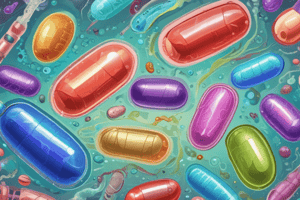Podcast
Questions and Answers
Which type of bacteria possess the genes to make a capsule?
Which type of bacteria possess the genes to make a capsule?
- Bacteria with offspring (correct)
- Bacteria in a biofilm
- Bacteria with quorum
- Bacteria without offspring
When are the genes to make a biofilm activated in bacteria?
When are the genes to make a biofilm activated in bacteria?
- When a bacterium is in a quorum (correct)
- When a bacterium possesses the genes to make proteins that help make a biofilm
- When a bacterium has enough offspring
- When a bacterium has a capsule
What is the difference between capsules and biofilms?
What is the difference between capsules and biofilms?
- Capsules are made of proteins, while biofilms are made of genes
- Capsules belong to a community of bacteria, while biofilms are an individual thing (correct)
- Capsules are activated when a bacterium has enough offspring, while biofilms are activated when a bacterium is in a quorum
- Capsules are always present on day one, while biofilms are only present in certain bacteria
Which of the following advantages do biofilms provide to bacteria?
Which of the following advantages do biofilms provide to bacteria?
Where are chronic infections and chronic inflammation commonly caused by biofilm-producing bacteria?
Where are chronic infections and chronic inflammation commonly caused by biofilm-producing bacteria?
What medical devices and implants etc provide a favorable environment for biofilms to attach to?
What medical devices and implants etc provide a favorable environment for biofilms to attach to?
Why do antibiotics and disinfectants sometimes fail to pass through biofilms?
Why do antibiotics and disinfectants sometimes fail to pass through biofilms?
Flashcards are hidden until you start studying
Study Notes
Capsule-Forming Bacteria
- Encapsulated bacteria possess specific genes that code for capsule production.
- Examples include Streptococcus pneumoniae and Escherichia coli which have polysaccharide-rich capsules.
Biofilm Gene Activation
- Biofilm formation genes in bacteria are typically activated in response to environmental changes, such as nutrient availability or surface attachment.
- Signaling molecules called autoinducers play a role in quorum sensing, enabling bacteria to coordinate the biofilm formation process.
Capsules vs. Biofilms
- Capsules are structured, protective layers surrounding individual bacterial cells, providing an immediate barrier to host defenses.
- Biofilms are complex communities of bacteria that adhere to surfaces and are embedded in a self-produced extracellular matrix, offering a synergistic environment for growth and protection.
Advantages of Biofilms
- Biofilms enhance bacterial resistance to antibiotics and disinfectants.
- They provide a stable environment for nutrient acquisition and protection from environmental stresses.
Chronic Infections and Biofilms
- Chronic infections and inflammation are often caused by biofilm-producing bacteria in conditions such as cystic fibrosis and catheter-associated urinary tract infections.
- Biofilms facilitate persistent infections due to their protective nature against immune responses.
Medical Devices Favoring Biofilm Attachment
- Medical implants, catheters, and prosthetic devices create favorable environments for biofilm formation due to their surfaces’ adherence properties.
- Foreign materials in the body increase the likelihood of biofilm development due to biocompatibility and nutrient presence.
Antibiotic Efficacy Against Biofilms
- Biofilms limit the penetration of antibiotics and disinfectants due to their dense structure and the protective extracellular matrix.
- Nutrient gradients and slower metabolic rates within biofilm communities contribute to reduced susceptibility to antimicrobial agents.
Studying That Suits You
Use AI to generate personalized quizzes and flashcards to suit your learning preferences.




